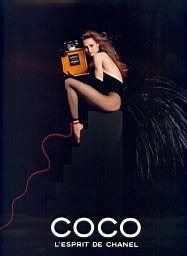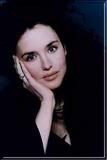In my previous entry I got the ball rolling and discussed the merits and progression ofChanel #5commercials in an effort to elucidate what fantasy can do for advertising purposes when done stylishly. Perfume advertising’s power lies in its ability to make us dream, to yield in escapism bringing into play an array of male and female types from mythologies which meld standard notions of what man and woman stand for. Those types address the natural and essential aspiration of consumers to partake of a desired personality. This takes either one of two possible ways: to be different, that is to become the person we would like to be; or, to be oneself, to affirm the person we believe ourselves to be. Of course fantasy is not exclusive to Chanel #5 as today’s post is going to show. There are other commercial clips aired on TV that have relied on the exploitation of sublime ideas far above the normal realm of what a perfume conveys, which would be smelling good. In this domain Chanel does excel it seems as they really do give a thought about it and they employ only top-notch professionals. The results speak for themselves.
Proof for that is one of their greatest commercials to date, the classic one for Egoiste, a men’s perfume from 1990. The commercial is brilliantly set to Prokofiev’s music from his ballet Romeo and Juliet “dance of the knights”. The magisterial, eerie and ominous score opens the scene when women shot in black and white cry and spell curses on the egoist male “hero” who has been tormenting them, daring him to show his face. As soon as a male hand opens one blind in what looks like a luxe French hotel, leaving the bottle of the Chanel product on the sill, the film turns into colour and the women enraged at his arrogance to show up so provocatively bang their shutters crying out “Egoist” with all their might. It is worth noting that all gowns are designed by Karl Lagerfeld, not two are the same, but also even the interiors of the briefly glimpsed rooms are all decorated differently.This is no typical advertising, in that it does not try to present any desirable trait on first reading, in compliance with the very imaginative use of the perfume’s name, which otherwise would guarantee its flop. The male protagonist remains unknown as we never see him fully, but his exploitations, although of a dubious moral substance, create a sense of primitive male pride in conquering in the stakes of female hunting.This consolidates the stereotype of a male Lothario who appears just in time that women have established their prowess in the workforce and perhaps feel the need to regress in their more feminine role of the hunted. The French have always depicted their female role-models in their advertisements as passive anyway, the myth equivalent of Venus in contrast to the independent Diana of the American prototype. If the advertising seemed daring and provocative enough in its depiction of the sexes, it is a testament to its artistry that sixteen years later Egoiste is still with us, a wonderful men’s perfume chosen by discerning women even for themselves, set to a terrific commercial that has written advertising history single-handedly. Watch the clip clicking here
Egoiste had a follow-up flanker perfume,
Next in our discussion of fantasy in terms of perfume advertising comes the controversial and rare gem of Obsessionby Calvin Klein in 1985. This clip comes from beforeObsession became tied to overt sexual provocateur imagery painted with Bruce Weber’s aesthetic and certainly long before the Kate Moss anorexic ads of the mid90s. It aired briefly because of pedophile overtones that aptly tied with the effulgent tag line “Love is child’s play once you’ve known Obsession”. It cost it swift termination though and an ingenious spoof acted out on Saturday Night Live for “Compulsion”. In this clip a young boy of no more than 12 is reminiscing about a young woman who seems to be the object of his obsession, unattainable and therefore desirable, an idol for his worship, for which he wonders if she was real or whether he invented her. the inclusion of chess scene conveys a celebral quality as well, also being a scheming hint that requires thought. The young female model is wholesome and at the same time mesmerizing in a peculiar way, without ever becoming vulgar. The models all wear the classic casual-chic neutral palette of Calvin Klein with plain yet somehow distinctive tailoring that helped Klein become a force in the American fashion scene. The female protagonist, a Diana-like effigy in her slender athletic physique and stance manages to instill desire and yearning, making us want to become such a powerful impression on someone else’s mind as well. Of course the choice of an adolescent boy over which she exerts her power might be attributed either to advertisers being hesitant to completely overturn the tables and show female dominance over a studly mature male or else a penchant of Klein for adolescence and the provocation angle this offers. We might as well consider the equally controversial print campaign for his Jeans line at the end of the 90s, when adolescents posed in sets that resembled 70s pornographic photos from gay magazines. That one raised hell as well earning it banning. It is safe to assume that Calvin Klein has always cleverly capitalized on sex and its implication, pushing the limits on many of his ad campaigns and yet, his outlook and aesthetic although daring and challenging has not become vulgar or common like campaigns of late, Tom Ford’s direction for Paris perfume for Yves Saint Laurent for instance or Dior Addict displaying acres of glistening naked skin. Klein did show skin a lot, especially in the carnal decade, but somehow (perhaps naively) you got the impression that he really did like the images and did not only do it for the bucks. Watch the clip clicking here
Speaking of using sex as a selling point done in a completely fascinating way can be witnessed in the following Shalimar by Guerlain commercial. Rare and coming from 1984, it exploits the rich history of this legendary scent by genious Jacques Guerlain. Named after the gardens where a royal tale of love bloomed resulting in one of the greatest monuments on earth, the Taj Mahal, Shalimar has from the start been inextricably tied to seduction and oriental mystique. Said commercial is distinctly 80s in its imagery, using the glamorous and sensuous images of that time frame and a brief retro shot of the Prohibition 20s in sepia, reminding as that Shalimar is “as close to forever as a perfume can go” ( the most fitting tagline ever!). Set to what sounds like a ChopinNocturne (although I haven’t checked, so I might be wrong) it creates a mood ripe for romance, galvanizing our imagination. Racy and yet tasteful, from sucking on candy to the purring voice-over, from the wet splashing on a fully made-up face that was oh-so-now back then to the shot of a foot fetishly shod in a high heeled sandal, it manages to make women and men alike dream about seduction and sensuousness, achieving an esteemed place in my mind as one of the most memorable commercials I have ever seen. Watch the clip clicking here
To come full circle, no other than Chanel again for
Next post will tackle the difficult subject of gender play in advertising.
.jpg)






